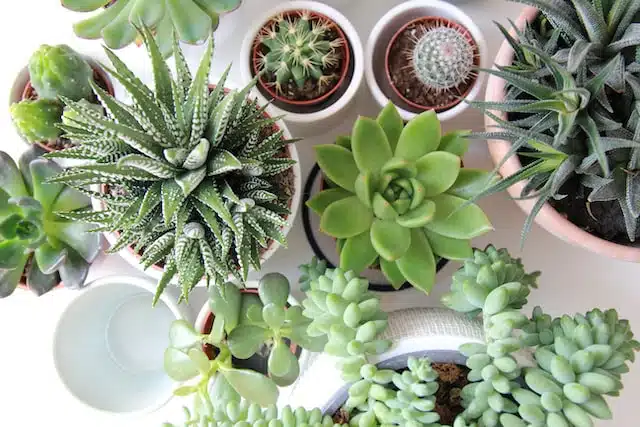Repotting and transplanting cactus and succulents

Like other plants, cactus and succulents need to be repotted, and their soil needs to be renewed every 2 to 3 years. The best time to do that is in summer, with dry soil and in a dry weather. Let’s learn more about repotting and transplanting cactus and succulents.
When does a cactus need to be repotted?
There are several reasons to repot a cactus or a succulent:
- When the pot has become too small. We will know it when the cactus comes out from the top of the pot or when the roots come out through the holes at the bottom of the pot.
- You have just bought it and the soil is not suitable for cactus, or the pot is too small.
- It has been in the same soil for more than two years, so it has lost its nutritional properties.
How to make a cactus transplant
- Prepare the cactus pot. Most species develop their roots horizontally, which allows them to make better use of rainwater. For this reason, bonsai pots are often used for cactus or succulents.
- Remove the soil of the cactus without damaging it. First, put on gardening gloves to protect yourself and the plant. To remove the soil, use a spatula to separate it from the rim of the cactus pot. Then, carefully remove the soil, being careful not to damage the cactus. You can use tools such as a rake or a root scratcher.
- Look for roots in bad health and prune them.
- Now is the time to look for fungus or pests on the roots. If so, use a special pesticide or fungicide for cactus. Cinnamon powder is a very effective and natural one.
- If the roots have suffered during the substrate removal, let the cactus dry out in the sun for a couple days or apply a fungicide on the roots.
- Prepare the bottom of the cactus pot with gravel to allow a good drainage. Then add a specific soil for cactus. Leave a hole in the centre to put the plant in.
- Put your cactus or succulent in the hole. Fill in the spaces. With the help of a chopstick, you can push the soil to make sure there are no air spaces. Make sure that the cactus is well fixed to the pot and does not move.
- Do not water the cactus or succulent in the following weeks after the transplant, except if you have transplanted offshoots, for which the substrate should be slightly moistened.

Tips for repotting and transplanting cactus and succulents
- Use a special cactus soil with a drainage layer such as gravel or Akadama.
- Avoid waterlogging. If you use a saucer, be careful that the water does not remain on it.
- Use repotting mesh in the drainage holes, it will help you to remove the cactus more easily in the next repotting.
Now that you know more about repotting and transplanting cactus and succulents, ¡Prepare your plants to look their best!
About the Author
Mistral Bonsai
In Mistral Bonsai we are a communication team, technicians and masters committed from the first day to disseminating the wonderful art of bonsai. A world that offers many things to share. We believe that a bonsai is a tree with a soul, unique and unrepeatable. Another of our most essential pillars is, how could it be otherwise, our close commitment to the preservation of the environment and nature.
Categories
Bonsai cultivation and care (54)
Bonsai gift (2)
Bonsai pests and diseases (6)
Bonsai repotting (3)
bonsai substrates (2)
bonsai tools (1)
Bonsai work (10)
Ceramic pots (3)
Chinese culture (1)
Chinese culture (2)
Corporative Mistral Bonsai (8)
Cuidados del bonsái (22)
Cultivo del bonsái (20)
Dead wood (2)
